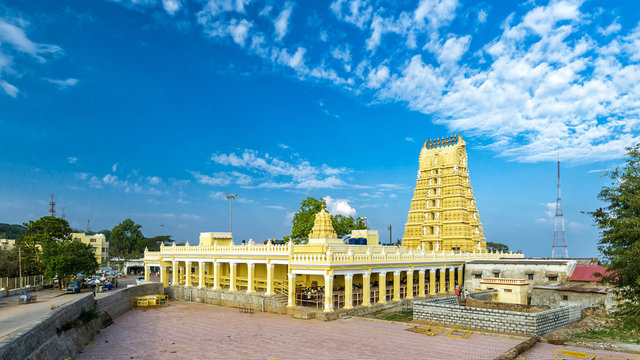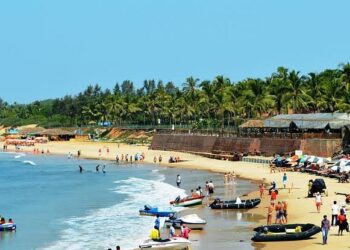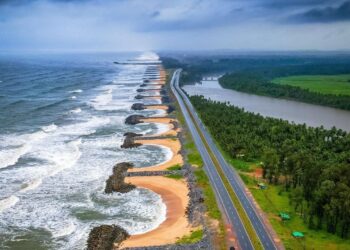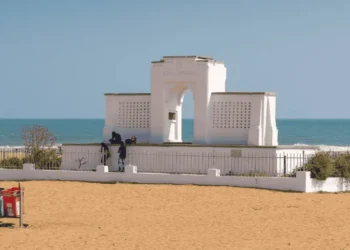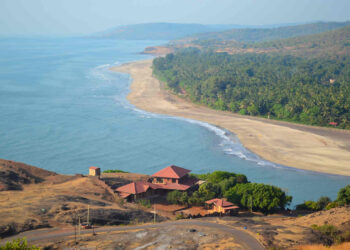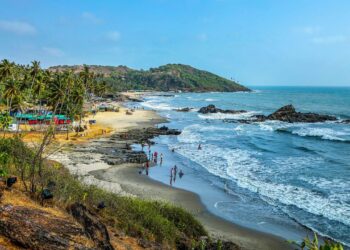The Chamundeshwari Temple rests atop Chamundi Hills in Mysuru, Karnataka, a sacred home for Goddess Chamundeshwari, a fierce form of Ma Durga. Sitting 1,000 meters high, with views of Mysuru’s old palaces, this temple is just 13 km from Mysuru city. Covering about 2 acres, its bright gopuram, carved halls, and peaceful grounds bring in pilgrims, history lovers, and travelers from all around India. Known for its place in Mysuru’s huge Dasara festival, the temple holds the city’s faith and history, filled with soft chants, the smell of flowers, and the prayers of many devotees.
Legend of the Temple
The Chamundeshwari Temple has stories and legends. One main tale comes from the text of Devi Mahatmyam. Long ago, a demon called Mahishasura, almost impossible to beat, troubled the gods. They called out to the Mother Goddess and she took the form of Durga, who fought him for nine days on these hills. On the tenth day, she took his head, becoming Mahishasura Mardini. The hills and Mysuru, once Mahishuru, got their names from him, and the temple honors her victory. People say praying and worshipping the goddess here protects them, as Chamundeshwari watches over the land.
Another story tells of King Dodda Devaraja Wodeyar in the 1600s. Facing danger in his kingdom, he saw the goddess in a dream, promising to protect him if he fixed her temple. He did, and Mysuru grew powerful, making Chamundeshwari the Wodeyars’ special goddess. These tales make the temple feel warm, like the goddess is still guarding Mysuru.
History of the Chamundeshwari Temple
The temple’s beginnings go far back, maybe before anyone wrote things down. A stone writing from 200 BCE nearby hints people prayed here early on, but the temple we see started in the 12th century with the Hoysalas. A carving from 1659 says Dodda Devaraja Wodeyar made it bigger, building the seven-story gopuram. The Wodeyars, who ruled Mysuru from the 1300s to 1900s, were its biggest helpers, giving gold, land, and oil for lamps, as old stones show.
By the 1600s, the temple was a lively place, with farmers, traders, and priests keeping it strong, old records say. The Vijayanagara kings, from the 14th to 16th centuries, added walls on the hills, tying the temple to their lands. In 1610, Raja Wodeyar I chose Chamundeshwari as the family’s goddess, linking her to Mysuru’s Dasara. The Marathas held Mysuru for a short time in the 1700s, then Hyder Ali and Tipu Sultan, who liked the temple and gave a green lingam. The British took over by 1832, and in 1947, Karnataka’s government stepped in, with the HR&CE Board running it now.
The temple’s holy history lives in Kannada writings and songs by saints like Purandara Dasa, who sang for the goddess and helped Karnataka’s Bhakti ways grow. As a Shakti temple, it pulls in thousands looking for her strength, making it a key part of Karnataka’s culture.
Architecture of the Temple
The Chamundeshwari Temple mixes Dravidian and Hoysala styles, covering 2 acres. Its seven-story gopuram, 40 meters tall, is covered with carvings of Durga’s battles, dancers, and lion-like yalis, painted red and gold. A silver door, given by Krishnaraja Wodeyar III in 1827, leads to the sanctum, where the 8th-century black stone Chamundeshwari idol glows with gold. A small shrine for Parvati as Bhuvaneshwari is close by.
The main holy room, rebuilt in 1659, has silver doors with god pictures. The navaranga hall, with 16 stone pillars, shows scenes from the Devi Mahatmyam and Wodeyar signs. A 16-foot Nandi statue, carved in 1659, sits 1 km down the hill, looking at the goddess. The courtyard has a holy tank, Chamundi Tirtha, for washing before prayers. Shrines for Ganesha, Shiva, and Hanuman are around. Wall paintings from the 1800s, fixed by the ASI, show Durga’s win against the demon, making every spot a piece of the past.
The temple’s carvings and festivals keep Hoysala and Wodeyar art alive. Songs by saints like Kanakadasa, sung during prayers, carry Karnataka’s Bhakti spirit. Its hilltop spot, looking over Mysuru’s old places, ties it to the city’s past as a culture hub, near spots like Srirangapatna.
Festivals and Rituals
The temple comes alive during festivals, especially Mysuru Dasara in September or October, a 10-day celebration from Wodeyar times. On Navaratri’s ninth day, Chamundeshwari’s idol rides in a gold howdah on an elephant, walking through Mysuru with music and lights, drawing tons of people. Maha Shivaratri has prayers all night, and Ashada Navaratri in July honors the goddess with lamps and songs. Six daily rituals, from 6 AM to 9 PM (free to enter, ₹50 for fast darshan), have priests offering rice, jaggery, and flowers, with the Chamundi mantra sounding loud.
Carnatic music, with veenas and drums, and Bharatanatyam dances telling Durga’s stories fill the air. Dasara’s Jumboo Savari, known all over, mixes faith and fun, as locals share tales of Chamundeshwari’s care. The temple makes Mysuru Karnataka’s culture center.
It’s easy to visit, a 15-minute drive from Mysuru or a 1,000-step climb up the hill. Pilgrims often see Jwalamukhi Tripura Sundari Temple nearby or go to Srirangapatna (16 km) or Somnathpur’s Hoysala temple (35 km).
Final Thoughts
The Chamundeshwari Temple is one of the best example of temples which reflects Karnataka’s legendary past. The Chamundeshwari Temple is a gem where the goddess calls her devotees, many from India and far away, where her holy spirit lives in every stone and step making it a must visit among temples in Karnataka.
